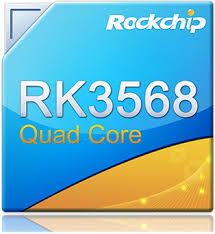
RK3568 Powers Next-Gen Embedded Systems with Unmatched Versatility
The embedded systems landscape has evolved rapidly over the past decade, driven by the demand for high-performance, low-power solutions across industries like IoT, automotive, and industrial automation. At the heart of this transformation lies the RK3568, a quad-core SoC (System on Chip) developed by Rockchip, designed to bridge the gap between efficiency and capability. With its Cortex-A55 architecture, Mali-G52 GPU, and support for multiple display interfaces, the RK3568 has emerged as a cornerstone for developers seeking robust platforms for modern applications.
Section 1: Technical Breakdown of the RK3568’s Architecture
The RK3568 is built on a 22nm process, featuring a quad-core Cortex-A55 CPU clocked up to 2.0 GHz. This architecture ensures a balance between performance and power efficiency, making it ideal for edge computing devices. The integrated Mali-G52 GPU supports OpenGL ES 3.2 and Vulkan 1.1, enabling smooth graphics rendering for applications like digital signage and gaming consoles. Additionally, the RK3568 includes a dedicated NPU (Neural Processing Unit) capable of 0.8 TOPS, catering to AI-driven workloads such as object detection and voice recognition.
One of the standout features of the RK3568 is its support for multiple display outputs, including HDMI 2.0, eDP, and MIPI-DSI, allowing up to three simultaneous displays at 4K resolution. This versatility makes it a go-to choice for multimedia applications. The SoC also supports DDR4 and LPDDR4 memory up to 8GB, ensuring scalability for memory-intensive tasks.
RK3568 Core Specifications
| Component | Specification | Notes |
|---|---|---|
| CPU | Quad-core Cortex-A55 | Up to 2.0 GHz, 22nm process |
| GPU | Mali-G52 2EE | OpenGL ES 3.2, Vulkan 1.1 support |
| NPU | 0.8 TOPS | For AI workloads |
| Display Support | HDMI 2.0, eDP, MIPI-DSI | Up to 4K, triple display |
| Memory Support | DDR4, LPDDR4 up to 8GB | High-speed memory options |
The RK3568’s architecture is not without limitations. While the Cortex-A55 cores are power-efficient, they lack the raw computational power of higher-end Cortex-A7x series CPUs found in competing chips like the Amlogic S922X. This trade-off positions the RK3568 as a mid-tier solution, best suited for applications where cost and energy efficiency outweigh the need for top-tier processing power.

Section 2: Applications Driving RK3568 Adoption
The RK3568 has found a foothold in diverse sectors due to its adaptability. In the IoT space, its low power consumption and support for multiple connectivity options—like PCIe, USB 3.0, and Gigabit Ethernet—make it a strong candidate for smart home gateways and industrial controllers. For instance, companies have leveraged the RK3568 to develop single-board computers (SBCs) like the Firefly RK3568J, which offer Raspberry Pi-like functionality with enhanced multimedia capabilities.
In automotive applications, the RK3568 powers in-vehicle infotainment (IVI) systems, providing high-quality graphics and real-time data processing for navigation and entertainment. Its ability to handle multiple camera inputs via MIPI-CSI also supports advanced driver-assistance systems (ADAS), such as parking assistance and lane departure warnings.
Another key area is digital signage, where the RK3568’s multi-display support shines. Retail chains and advertisers use RK3568-based systems to deploy interactive kiosks and video walls, benefiting from the chip’s ability to render 4K content smoothly while maintaining low operational costs.
However, the RK3568 faces competition from alternatives like the Qualcomm Snapdragon 625 or NVIDIA Jetson Nano in these domains. While the RK3568 excels in cost-effectiveness, it lags in GPU performance compared to the Jetson Nano, which is better suited for heavy AI workloads. This raises questions about whether the RK3568 can maintain its edge as application demands grow more complex.
Section 3: Development Ecosystem and Software Support
A critical factor in the RK3568’s success is its software ecosystem. Rockchip provides a comprehensive Board Support Package (BSP) that includes Linux and Android support, with versions like Ubuntu 20.04 and Android 11 pre-optimized for the SoC. The open-source community has also embraced the RK3568, with projects like Armbian offering custom distributions tailored for RK3568-based boards.
Developers benefit from the RK3568’s rich peripheral support, including GPIO, SPI, and I2C interfaces, which simplify integration with sensors and actuators. The chip’s NPU is compatible with frameworks like TensorFlow Lite, enabling lightweight machine learning models to run efficiently on edge devices.
RK3568 Software Ecosystem Comparison
| Feature | RK3568 Support | Competitor (e.g., Jetson Nano) |
|---|---|---|
| OS Support | Linux, Android, Ubuntu | Linux, Ubuntu |
| AI Frameworks | TensorFlow Lite | TensorFlow, PyTorch |
| Community Support | Armbian, OpenWrt | NVIDIA Forums, ROS |
| Development Tools | Rockchip SDK, GCC | NVIDIA JetPack, CUDA |
Despite these strengths, software optimization remains a challenge. The RK3568’s NPU, while functional, lacks the robustness of NVIDIA’s CUDA ecosystem, which offers better tools for AI development. Additionally, Rockchip’s documentation can be sparse, posing hurdles for developers unfamiliar with the platform. Addressing these gaps could solidify the RK3568’s position in the developer community.
Section 4: Market Challenges and Future Prospects
The RK3568 operates in a crowded market where cost, performance, and ecosystem support dictate success. Priced competitively—development boards like the Radxa ROCK3A start at around $50—the RK3568 offers a compelling value proposition. However, its mid-tier performance limits its appeal for high-end applications like autonomous robotics or real-time 3D rendering, where chips like the NVIDIA Jetson Xavier NX dominate.
Another challenge is the global semiconductor shortage, which has impacted RK3568 availability. While Rockchip has scaled production, supply chain constraints have delayed projects for smaller manufacturers relying on the chip. This has driven some developers to explore alternatives like the Allwinner H616, though it lacks the RK3568’s display and AI capabilities.
Looking ahead, the RK3568’s future hinges on Rockchip’s ability to enhance its ecosystem and address performance gaps. Potential upgrades, such as improved GPU drivers or a next-gen NPU, could expand its applicability in emerging fields like 5G edge servers or AR/VR devices. For now, the RK3568 remains a solid choice for cost-sensitive projects that don’t require cutting-edge computational power.

Balancing Innovation and Practicality with RK3568
The RK3568 exemplifies the trade-offs inherent in modern SoC design: it delivers impressive versatility and efficiency at a competitive price but falls short in raw performance compared to high-end alternatives. Its role in IoT, automotive, and digital signage underscores its practical value, while its software ecosystem offers a foundation for innovation. Yet, as industries demand more from embedded systems—faster AI, richer graphics, seamless connectivity—the RK3568 must evolve to stay relevant. For developers and businesses, it represents a pragmatic choice today, with the promise of greater potential tomorrow.
Footnotes
- Cortex-A55: A 64-bit ARMv8-A CPU architecture designed for energy-efficient performance, commonly used in mobile and embedded devices.
- Mali-G52 GPU: A graphics processing unit from ARM, optimized for mid-range devices with support for modern APIs like Vulkan and OpenGL ES.
- NPU (Neural Processing Unit): A specialized hardware accelerator for machine learning tasks, improving efficiency in neural network computations.





The news about this product first appeared in reports on **November 4, 2024**, from sources including **Tux Machines** and **LinuxGizmos**, highlighting features such as **dual Gigabit Ethernet** and **PoE+ support**. Additionally, detailed product specifications were confirmed on **Engicam’s official website**, under **Engicam V.Board RK3568**.
In subsequent searches, news from **January 2025** primarily focused on other market trends, such as the **humanoid robot market**, without directly mentioning any new product releases related to the **RK3568**.
As edge computing gains traction, the RK3568’s capabilities in handling lightweight machine learning tasks—such as real-time image recognition in security cameras or voice processing in smart speakers—make it a quiet contender. While not as powerful as high-end GPUs, its low power consumption and cost-effectiveness push the boundaries of deploying AI at the edge, sparking debates on scalability versus centralized cloud reliance in future tech ecosystems.